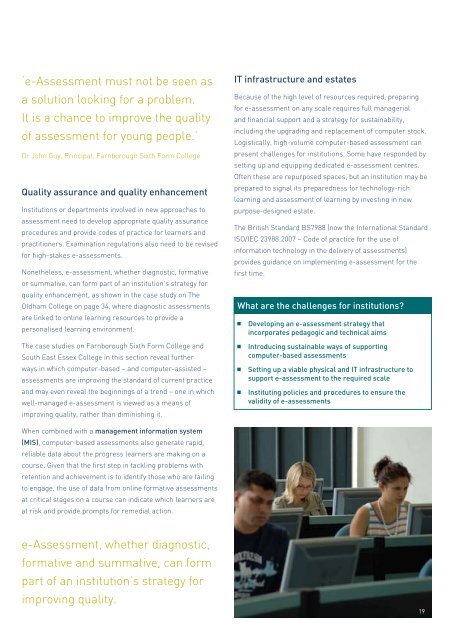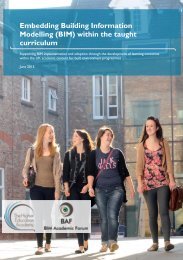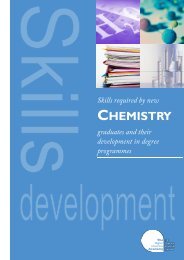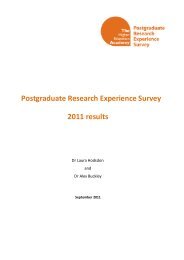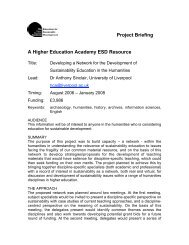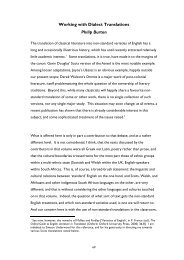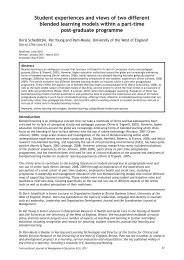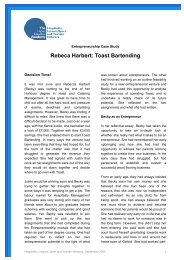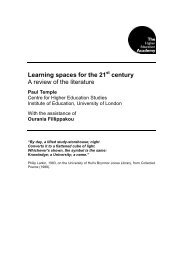Effective Practice with e-Assessment: An overview of ... - Jisc
Effective Practice with e-Assessment: An overview of ... - Jisc
Effective Practice with e-Assessment: An overview of ... - Jisc
Create successful ePaper yourself
Turn your PDF publications into a flip-book with our unique Google optimized e-Paper software.
‘e-<strong>Assessment</strong> must not be seen as<br />
a solution looking for a problem.<br />
It is a chance to improve the quality<br />
<strong>of</strong> assessment for young people.’<br />
Dr John Guy, Principal, Farnborough Sixth Form College<br />
Quality assurance and quality enhancement<br />
Institutions or departments involved in new approaches to<br />
assessment need to develop appropriate quality assurance<br />
procedures and provide codes <strong>of</strong> practice for learners and<br />
practitioners. Examination regulations also need to be revised<br />
for high-stakes e-assessments.<br />
Nonetheless, e-assessment, whether diagnostic, formative<br />
or summative, can form part <strong>of</strong> an institution’s strategy for<br />
quality enhancement, as shown in the case study on The<br />
Oldham College on page 34, where diagnostic assessments<br />
are linked to online learning resources to provide a<br />
personalised learning environment.<br />
The case studies on Farnborough Sixth Form College and<br />
South East Essex College in this section reveal further<br />
ways in which computer-based – and computer-assisted –<br />
assessments are improving the standard <strong>of</strong> current practice<br />
and may even reveal the beginnings <strong>of</strong> a trend – one in which<br />
well-managed e-assessment is viewed as a means <strong>of</strong><br />
improving quality, rather than diminishing it.<br />
IT infrastructure and estates<br />
Because <strong>of</strong> the high level <strong>of</strong> resources required, preparing<br />
for e-assessment on any scale requires full managerial<br />
and financial support and a strategy for sustainability,<br />
including the upgrading and replacement <strong>of</strong> computer stock.<br />
Logistically, high-volume computer-based assessment can<br />
present challenges for institutions. Some have responded by<br />
setting up and equipping dedicated e-assessment centres.<br />
Often these are repurposed spaces, but an institution may be<br />
prepared to signal its preparedness for technology-rich<br />
learning and assessment <strong>of</strong> learning by investing in new<br />
purpose-designed estate.<br />
The British Standard BS7988 (now the International Standard<br />
ISO/IEC 23988:2007 – Code <strong>of</strong> practice for the use <strong>of</strong><br />
information technology in the delivery <strong>of</strong> assessments)<br />
provides guidance on implementing e-assessment for the<br />
first time.<br />
What are the challenges for institutions?<br />
g<br />
Developing an e-assessment strategy that<br />
incorporates pedagogic and technical aims<br />
g<br />
g<br />
g<br />
Introducing sustainable ways <strong>of</strong> supporting<br />
computer-based assessments<br />
Setting up a viable physical and IT infrastructure to<br />
support e-assessment to the required scale<br />
Instituting policies and procedures to ensure the<br />
validity <strong>of</strong> e-assessments<br />
When combined <strong>with</strong> a management information system<br />
(MIS), computer-based assessments also generate rapid,<br />
reliable data about the progress learners are making on a<br />
course. Given that the first step in tackling problems <strong>with</strong><br />
retention and achievement is to identify those who are failing<br />
to engage, the use <strong>of</strong> data from online formative assessments<br />
at critical stages on a course can indicate which learners are<br />
at risk and provide prompts for remedial action.<br />
e-<strong>Assessment</strong>, whether diagnostic,<br />
formative and summative, can form<br />
part <strong>of</strong> an institution’s strategy for<br />
improving quality.<br />
19


